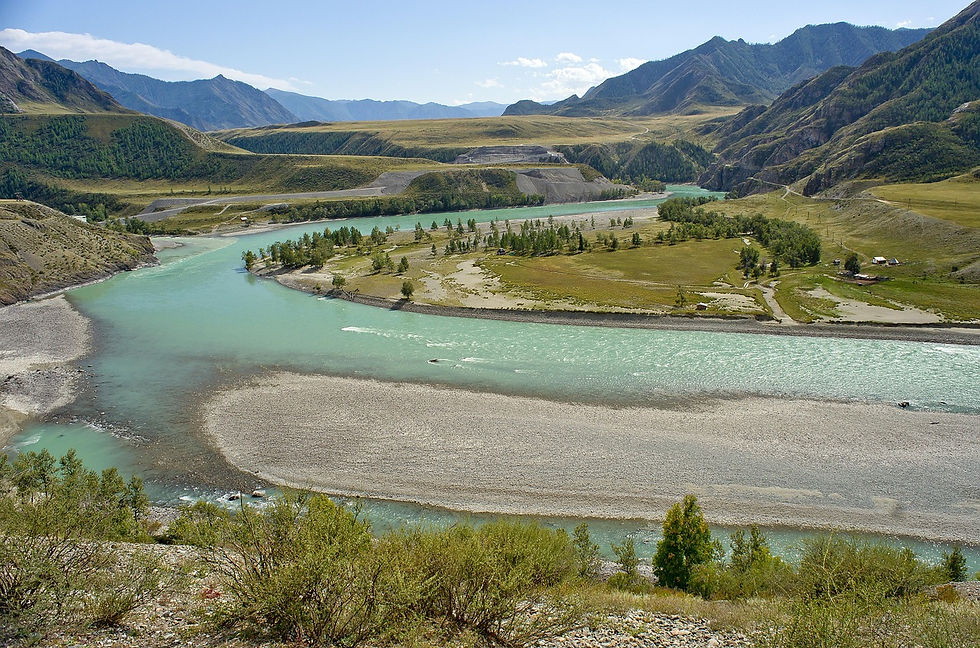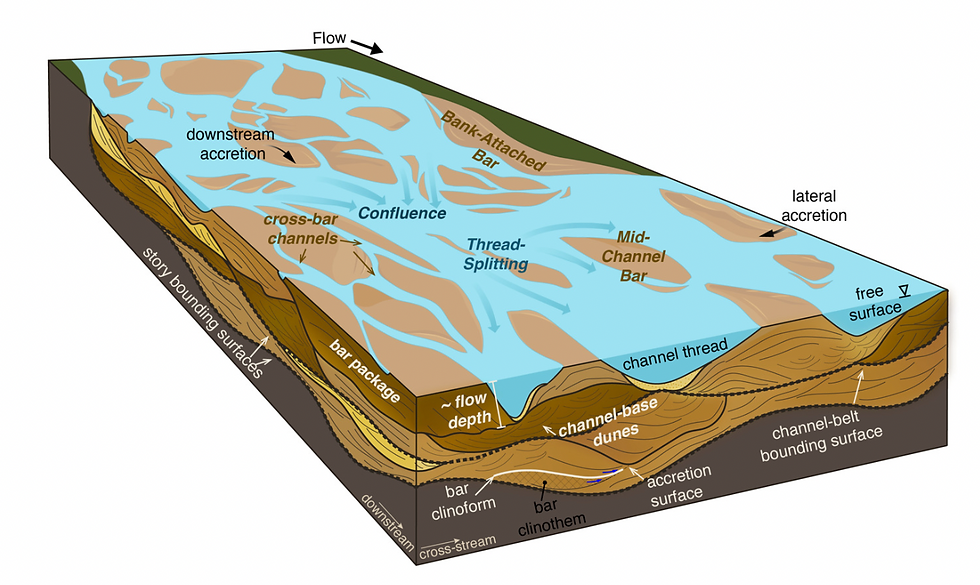Dynamic River Landscapes: Braided Rivers, Rapids, and Pools and Riffles
- Tom McAndrew

- Sep 22
- 6 min read

Rivers are among the most dynamic and fascinating systems on Earth, constantly shaping and reshaping the landscapes through which they flow. From wide floodplains to steep gorges, the geomorphological features created by flowing water are as varied as they are impressive. Three features in particular—braided rivers, rapids, and pools and riffles—stand out for their distinctive forms and processes.
Braided Rivers: Tangled Threads of Water
Few river features are as striking as braided channels. Seen from above, they resemble plaited ropes or tangled threads, weaving in and out of one another across wide valley floors. Famous examples include the Brahmaputra in Bangladesh, the Platte River in the United States, and parts of the River Rhône in Switzerland.
Braided rivers form where the river carries an exceptionally high sediment load, often dominated by coarse materials such as gravel and sand. When a river cannot transport all of this material in suspension or by traction, deposition occurs within the channel itself. These deposits create unstable mid-channel bars and islands that disrupt the flow of water. Instead of maintaining a single channel, the river splits into multiple shifting channels that weave around these islands.
A key factor in braiding is river discharge variability. Rivers that experience strong seasonal changes—such as those fed by glacial meltwater or monsoon rainfall—are particularly prone to braiding. During high flow, channels may scour out large amounts of sediment, while in low flow, deposition dominates, choking the channel with new bars and islands. Over time, this alternation builds the constantly changing braided pattern.
Channel gradient also plays a role. Braided rivers typically occur in areas with relatively steep gradients, where high-energy flows mobilise coarse sediments. This contrasts with meandering rivers, which tend to form on gentler gradients where fine sediments dominate and deposition occurs on the inside bends of sweeping curves.
The resulting braided channel is inherently unstable. Islands form and disappear, channels shift position, and floods can completely rearrange the pattern. This instability makes braided rivers hazardous for human use. Settlements and agricultural activity along their banks face regular threats of erosion and flooding, while navigation is virtually impossible. Yet braided rivers also create fertile floodplains as sediments are regularly replenished, making them attractive to farming communities despite the risks.
The braided Brahmaputra in Bangladesh illustrates both the challenges and benefits of such systems. The river’s constantly shifting channels destroy farmland and villages each year, forcing communities to adapt by building temporary housing and moving when necessary. Yet the same river supports millions through fertile soils and rich fisheries, highlighting the paradox of braided rivers in human geography.
Rapids: Rivers in Turbulence

Moving upstream into steeper landscapes, the river takes on a very different character. Here, in mountain valleys or upland gorges, rivers frequently form rapids—sections where turbulent water rushes over rocky steps, producing foaming white water. To many, rapids are synonymous with adventure sports like rafting and kayaking, but in physical geography, they are a clear indicator of underlying geology and river energy.
Rapids form when the river encounters sudden changes in gradient or variations in the resistance of the bedrock. If harder rock outcrops alternate with softer, more easily eroded layers, the river erodes the weaker rock more quickly. This differential erosion produces irregular steps in the riverbed. As water flows over these steps, it accelerates and becomes turbulent, creating the churning, frothing effect we recognise as rapids.
In some cases, rapids occur because of recent tectonic uplift or glacial activity, both of which can leave rivers “over-steepened” relative to their equilibrium profile. Where glaciers carved deep troughs but then retreated, rivers may be left cascading down gradients that are steeper than normal, producing rapids and waterfalls.
Rapids are not only visually dramatic but also important ecologically. The turbulence oxygenates the water, creating habitats ideal for certain fish species and invertebrates. At the same time, they act as natural barriers to navigation, limiting river transport in mountainous regions. For example, the Congo River—one of the world’s most powerful—features extensive rapids such as the Inga Rapids, which render large stretches unnavigable but provide huge potential for hydroelectric power generation.
From a geomorphological perspective, rapids are temporary features in the long timescale of river evolution. Over thousands of years, rivers erode their channels towards a smooth graded profile, removing irregularities. However, where tectonic activity or resistant rock persists, rapids may remain long-term fixtures of the landscape.
Pools and Riffles: Rhythms of the River

In contrast to the dramatic spectacle of braided channels or rapids, pools and riffles represent a subtler but equally important feature of river systems. Typically found in the middle courses of rivers, they occur in sequences that reflect the interaction of flow velocity, sediment transport and channel morphology.
A pool is a deeper section of the channel where water flows more slowly. Riffles, by contrast, are shallow, gravelly sections where water flows more quickly and often forms small waves. Together, pools and riffles create a repeating pattern along the river, usually at intervals of five to seven channel widths.
Their formation is linked to helicoidal flow—the corkscrew-like movement of water within the channel. As rivers flow around gentle bends, helicoidal currents move sediment from the outside of one bend (where erosion dominates) to the inside of the next (where deposition occurs). This process sets up alternating zones of erosion and deposition, leading to the development of deeper pools and shallower riffles.
The distribution of energy is key. Pools form where velocity is highest, often on the outside of bends, which scours the channel bed and deepens it. Riffles develop where velocity slows, allowing gravel and coarser material to accumulate. This alternation creates a dynamic equilibrium: pools store energy and sediment during high flows, while riffles regulate flow by increasing turbulence and reducing erosive power.
Pools and riffles are not just academic curiosities. They are crucial for river ecology, providing habitats for fish spawning and invertebrate communities. The contrast between slow, deep pools and fast, shallow riffles ensures biodiversity, making these sequences an integral part of river health. River restoration projects often involve recreating pools and riffles to restore natural flow regimes and improve habitats degraded by channelisation or dredging.
Comparing the Features
Although braided rivers, rapids, and pools and riffles differ in form and scale, they share an underlying theme: they are all responses to imbalances between energy, sediment and channel conditions. Braided rivers result from sediment overload and fluctuating discharge, rapids from irregular gradients and resistant geology, and pools and riffles from the redistribution of sediment by helicoidal flow.
All three also highlight the dynamic equilibrium at the heart of fluvial systems. Rivers constantly adjust to changes in discharge, sediment load, and gradient, seeking to balance erosion and deposition. When one factor shifts, new landforms develop. This makes rivers excellent case studies for systems thinking in geography, as well as vivid illustrations of how physical processes shape landscapes.
Human Impacts and Management
In the modern world, human activity increasingly interacts with these features. Braided rivers are often affected by dam construction upstream, which traps sediment and reduces braiding downstream. Conversely, deforestation and land-use changes can increase sediment load, intensifying braiding. Managing these rivers requires careful balancing between reducing hazards and maintaining ecological benefits.
Rapids have become valuable for hydroelectric power, as seen in the harnessing of turbulent sections of the Paraná and Congo Rivers. However, damming rapids also disrupts ecosystems and displaces communities, raising complex questions about sustainability.
Pools and riffles are particularly sensitive to human modification. Channel straightening or dredging removes the natural alternation, reducing habitat diversity and increasing flood risk downstream. River restoration efforts in Britain and elsewhere increasingly focus on reinstating pool-riffle sequences to enhance biodiversity and restore natural processes.
Sources of Information
Bridge, J. S. (2003). Rivers and Floodplains: Forms, Processes and Sedimentary Record.
Blackwell Publishing. Knighton, D. (2014). Fluvial Forms and Processes: A New Perspective.
Routledge. Leopold, L. B., Wolman, M. G., & Miller, J. P. (1964). Fluvial Processes in Geomorphology.
W.H. Freeman. National Geographic (2023). “Braided Rivers: Nature’s Unstable Waterways.” Available at: www.nationalgeographic.com
Petts, G. & Calow, P. (1996). River Flows and Channel Forms. Blackwell Science. Smith, N. D. (1970). “The braided stream depositional environment: comparison of the Platte River with modern gravel-bedded rivers.” Geological Society of America Bulletin, 81(10), pp. 2993–3014.







Comments